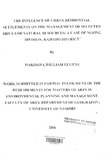| dc.description.abstract | Urban growth and (associated urban facilities such as residential settlements are a continuous challenge onto the environment, Residential areas are home to urban areas most important human resource and are a reserve for urban arears labour, often they act as interlinks and offloads points for human labour arriving from rural areas They provide markets for ready goods and services within urban areas, and as such,not only consume but drive the urban areas productive processes. Urban areas demand for food, water, energy (fossil and human), and raw material for production processes, as well as management of waste products from its vital processes. Having this knowledge, this study set out to examine natural resource use; soil, water and vegetation (Products and service) for the urban area occurring Oil the margins of the ASALs given limited availability of resources in these lands. Particularly attention was paid small urban areas that have grown as all outward influence of growth of the city of Nairobi The role of increased residential settlements visa a vis natural resource use occasioned by mechanical breakdown and power failures at borehole j installations and sometimes dry seasons Competition for water has led to increased depth in sinking of boreholes to reach the receding water table. There is also increased vegetation clearance as a result of residential settlement, while incentive and initiative 10 green residential areas remain low. Soils are left bare, concretized or covered with stone chips to avoid mud. The study at agues, there is increased generation or sediments, surface run-off, and storm waters lrom residential areas as a result of construction and, soil compaction. Soils removed during construction and carried out of construction sites, arc at best used to fill old quarries or at worst, dumped on roadsides, river valleys and open fields destroying the scenic value of the area. In conclusion, the study argues, urban settlements on the margins of ASALs maybe detrimental to the environment especially where they clear vegetation and interfere with catchments areas and water recharge points. These may not only 'produce physical and topographical change but may also alter climate of these regions in the long-run. The study advocates for use of law in environmental management i.e. use of planning instruments such as Environmental Impact Assessments (EIAs), Environmental Audits (EJAs), Policy for settlement in arid areas, Community Education, advocacy and sensitization in settled areas among residential groups. Community mobilization for resource management should be done through neighborhood associations, conservation groups, establishment of (Pilot) ecological settlements and policing of settlements to meet certain stipulated requirements . | en |

